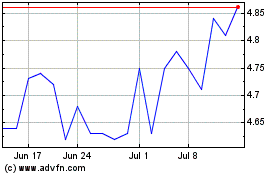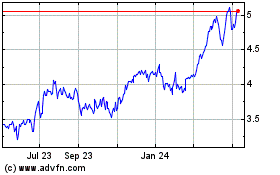By Jeannette Neumann
MADRID-- Banco Santander SA on Thursday reported a 5% rise in
third-quarter profit as stronger lending income in Europe helped to
counter weakness in Latin American countries hobbled by currency
declines.
The eurozone's largest bank by market value said net profit for
the quarter was EUR1.68 billion ($1.86 billion), roughly in line
with analysts' expectations of EUR1.7 billion, according to a poll
by data provider FactSet.
Profit increased in Santander's three main businesses--the U.K.,
Brazil and Spain.
"We view the economic situation as improving in the majority of
our core markets," said Santander's executive chairman, Ana Botín.
The bank highlighted annual economic growth expectations of more
than 3% in Spain, the U.S. and Poland and over 2.5% expansion in
the U.K., Mexico and Chile. Brazil and Argentina, on the other
hand, are contracting.
Santander said net interest income was EUR7.98 billion, up from
EUR7.5 billion in the same period last year, roughly in line with
analysts' forecasts of EUR7.9 billion. Net interest income, a key
driver of revenue for retail banks, is the difference between what
lenders pay clients for deposits and charge for loans.
At a regional level, net interest income figures showed weakness
in Latin America that was counterbalanced by somewhat stronger
lending in Europe.
Net interest income in Latin America fell more than 2% to EUR3.3
billion in the third quarter from a year earlier. In contrast, net
interest income rose nearly 7% in continental Europe during the
same period to about EUR2 billion.
Santander reported a "fully loaded" capital ratio of 9.85%, a
sliver higher than in the second quarter. Despite a hefty capital
increase in January, Santander's financial cushion remains below
its European banking peers.Santander is targeting a capital ratio
of more than 11% by 2018.
Santander "reported unsurprising third-quarter results, with
weak underlying trends and limited capital generation," said N+1
Group analyst Francisco Riquel. Santander shares were down 3%
around noon in Madrid.
One surprise for investors and analysts was a sharp decrease in
net profit from the U.S. both year-over-year and
quarter-over-quarter, triggered by the snowballing cost of tackling
regulatory problems there.
Santander remains caught in regulators' cross hairs for failing
to meet their standards on a range of basic business operations
such as how the bank's holding company manages its capital and
corporate governance. Ms. Botín has shaken up her management team
in the U.S. since she took over the bank in September 2014 and has
made it a priority to shape up in that market.
Santander Chief Financial Officer José García Cantera said he
expects U.S. regulatory costs to peak soon. "We have been investing
heavily to meet regulatory compliance expectations," Mr. Cantera
told analysts on Thursday. "We should see lower costs in the coming
quarters."
In the U.K., net profit was up 18% at EUR480 million in the
third quarter on stronger lending income and lower loan loss
provisions. One negative sign there was 6% decline in fees in the
third quarter compared with the second.
Profit at Santander's Brazil unit rose to EUR385 million from
EUR376 million on lower loan loss provisions. Net interest income
fell to EUR1.98 billion from EUR2.25 billion.
Accounted for in the Brazilian real, net profit and net interest
income both rose strongly during the third quarter. Santander
highlighted Brazil's slowing economy and an increase in the
unemployment rate to 7.6% in August from 6.9% in June. Inflation
was 9.5% in September.
Santander's Spanish business reported third-quarter net profit
of EUR311 million, up from EUR252 million a year earlier on sharply
lower loan loss provisions. However, net interest income fell
nearly 8%.
Net interest income also fell 2.2% in the third quarter from the
second quarter. Profit rose, however, in the third quarter from the
second on a greater-than-expected surge in income from trading.
Investors and analysts had expected a decline in net interest
income, a key profitability figure. Santander's Spain unit, like
other Spanish banks, faces sluggish borrowing demand and falling
yields on the loans it is issuing.
Santander said mortgage lending was up 33% in the first nine
months from a year earlier. But borrowers are still paying off
their loans at a faster rate than they are taking on new ones. Loan
volume in Spain was roughly the same as a year ago and fell from
the previous quarter as deleveraging continues in Spain despite an
improving economy.
Investors and analysts had also expected Santander's net
interest income in its Spain unit to take a slight hit from the
expense of funding a new, higher interest checking account, called
the 1|2|3 account.
The bank said Thursday that 140,000 of the 500,000 clients who
had signed up for Ms. Botín's signature product by the end of the
third quarter had transferred their payroll deposit from another
bank. Ms. Botín is betting on being able to sell new and existing
clients more products to boost profitability.
Santander Chief Executive José Antonio Álvarez told analysts
Thursday that the 1|2|3 account is likely to have a negative impact
of around EUR30 million to EUR40 million in Spain this year, and
should "break even" in 2016.
"This is out bet," Mr. Álvarez said, "To have more loyal
customers in Spain."
Write to Jeannette Neumann at jeannette.neumann@wsj.com
Subscribe to WSJ: http://online.wsj.com?mod=djnwires
(END) Dow Jones Newswires
October 29, 2015 07:09 ET (11:09 GMT)
Copyright (c) 2015 Dow Jones & Company, Inc.
Banco Santander (NYSE:SAN)
Historical Stock Chart
From Mar 2024 to Apr 2024

Banco Santander (NYSE:SAN)
Historical Stock Chart
From Apr 2023 to Apr 2024
